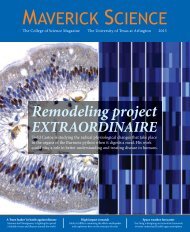Maverick Science mag 2013-14
Create successful ePaper yourself
Turn your PDF publications into a flip-book with our unique Google optimized e-Paper software.
Photo credits:<br />
Above and right,<br />
Brandon Wade; top<br />
right, Majie Fan.<br />
At top left, master’s student Sara Ayyash drills<br />
holes in a freshwater carbonate sample collected<br />
near Douglas, Wyoming, in order to collect<br />
the powder for stable isotope and element<br />
concentration analysis. Above, doctoral student<br />
Min Gao conducts primary field work last<br />
summer at Firehole Canyon in southwestern<br />
Wyoming, where the upper stream of the Colorado<br />
River cut the rocks formed in a lake environment<br />
about 52 million years ago. At left,<br />
Fan in her lab with master’s student Ohood Al<br />
salem, who is examining a thin section of sandstone<br />
collected in Wyoming. The thin section<br />
of sandstone, which dates from the Miocene<br />
epoch, can be seen on the computer monitor.<br />
ern soil and water samples in order to understand<br />
the stable isotope signatures of modern climate<br />
and environment, “because the interpretation of<br />
geologic data derived from the rock record relies<br />
on the understanding of such data in modern geologic<br />
context,” Fan said.<br />
The project has three goals, Fan said. The first<br />
is to investigate the occurrence and timing of a regional<br />
transition of post-Laramide basin fill from<br />
fluvial to eolian deposition, by applying field observations,<br />
sandstone petrography and detrital<br />
zircon geochronology study, and grain-size analysis.<br />
The second is to constrain the timing of surface<br />
elevation changes by reconstructing the<br />
stable isotope compositions of middle and late<br />
Cenozoic surface water and surface temperature<br />
from the combined analysis of hydrogen isotope<br />
ratios of volcanic glass, oxygen and clumped isotope<br />
ratios of pedogenic and lacustrine carbonates.<br />
The third is to evaluate and refine proposed<br />
competing mechanisms of formation of the high<br />
central Rockies.<br />
Gao spent three weeks last summer with Fan<br />
in Wyoming, locating areas with good outcrops<br />
from which to collect samples. Gao is focusing on<br />
sediment constraint and basin subsidence modeling<br />
in order to understand the influence of mantle<br />
upwelling on surface uplift when the subducting<br />
flat oceanic slab was detached underneath the<br />
continental plate.<br />
“In the next field trip, I will be working on<br />
measuring stratigraphic sections and collecting<br />
rock samples,” said Gao, who wants to teach and<br />
do research at a university in her native China<br />
after earning her Ph.D. “Specifically, after we find<br />
a good outcrop to work on, we will measure the<br />
thickness of every stratigraphic layer and record<br />
as many characteristics of the rock as possible,<br />
such as the lithology and the sedimentary structure.”<br />
The field work involves a great deal of hiking.<br />
Due to the remote location of the outcrops and in<br />
order to keep costs down, the team normally<br />
camps in tents.<br />
Fan and her students are in the final stages of<br />
lab data collection and have recently published<br />
one paper and submitted two others based on<br />
their research. They also have three papers in different<br />
stages of preparation. Their research has<br />
yielded the discovery that modern soil carbonate<br />
in the central Rocky Mountains is formed during<br />
the short periods of soil dewatering, which happen<br />
irregularly during hot summer weather.<br />
“This particularly challenges the previous assumption<br />
that soil carbonate is formed continuously<br />
during the growth season,” Fan said.<br />
They also found that the central Rockies and<br />
adjacent Great Plains in western Nebraska experienced<br />
another stage of uplift after the end of the<br />
Laramide orogeny, which caused concomitant<br />
drying in both areas. Lastly, they found that there<br />
was a regional transition from water-lain sedimentation<br />
to wind-lain sedimentation which occurred<br />
32-35 million years ago, and the transition<br />
became younging eastward.<br />
“The transition represented a regional drying<br />
event caused by the initiation of a rain shadow<br />
due to the uplift of the central Rocky Mountains.<br />
However, global cooling due to Antarctica glaciation<br />
at around 34 million years ago may be another<br />
factor causing the drying events. Such<br />
findings bring new research questions,” Fan said.<br />
In a separate project, Fan is teaming with Barbara<br />
Carrapa of the University of Arizona to research<br />
the temporal and spatial patterns of<br />
Laramide uplift to evaluate and refine the proposed<br />
competing geodynamic models of the tectonic<br />
processes during the Laramide orogeny.<br />
22 <strong>Maverick</strong> <strong>Science</strong> <strong>2013</strong>-<strong>14</strong>












